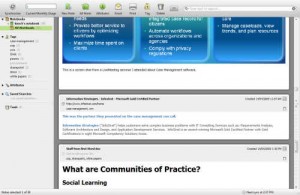
Note-taking is one of those things that get better with age, like wine or jazz. I didn’t take notes for many years at the beginning of my career, and I think I was significantly less productive because of it. In my day, I think university students weren’t taught to take good notes (I certainly wasn’t; in the Arts we were basically supposed to glean most of our inputs by reading books anyway).
The older I get, the more I realize that often, taking notes is the difference between success and failure. Writing things down, even informally, is the difference between having something to “show for it” and not having anything at all. Clients and coworkers respond surprisingly well to, “I have in my notes that you agreed to do X.”
The $8m question is how to best capture notes. Basically, there are three broad categories:
- Written notes on paper
- Written notes on a computer
- Audio notes using a digital audio recorder (that you’ll have to transcribe later).
In the course of the last 15 years, I somehow lost my ability to easily write by hand for long periods of time. My physiology must have adapted to using a keyboard most of the time. I have also, in the last few years, mastered the art of being fully present in meetings, participating, and still typing to take notes.
My note-taking tool of choice today is Evernote [1]. I’ve tried, at various times, Notepad, Word and OneNote. Notepad is just not practical for a variety of reasons; Word is easy to work in but doesn’t offer anything over and above what word processors offer; and OneNote (Microsoft’s note-taker, part of the Office suite) is full of good ideas but poor implementation: Being able to type anywhere on the page makes the notes’ reuse value low in other formats, and its lack of proper ‘cloud’ data storage makes it just impractical. (Yes, I realize it can be configured to store its notebooks on a shared folder on a corporate servers – but that means I would have to continually be connected to my office network somehow.)
Great features of Evernote:
- Notebook storage in the cloud
- Ability to work offline and synchronize new notes later
- Ability to install the client on multiple computers and operating systems (Windows, Mac, Linux)
- Ability to obtain client for mobile devices (still missing a BlackBerry client though, which I – and thousands of others – are waiting for…)
- Ability to send email to one’s notebook
- Ability to send pictures containing text to it – and it OCRs the words (white boards from meetings, pages in books in libraries or bookstores)
- Screen clipper always running: allows you to capture any screen region and save it as an image to your Evernote notebook, where its word contents will be OCR’ed and become searchable
- Firefox plugin to easily add web text (including the source URL) to the notebook
- All notes are also available through the web interface when you’re at a computer that doesn’t have the client software installed.
Each of these would be a great feature by itself; together, they offer the greatest feature density of any note-taking applications I’ve looked at. There are, however, some things that could be vastly improved in Evernote:
- The ‘pop-up’ text editor: it’s unfortunately not really good enough. Both Word and OneNote provide a significantly better user experience than Evernote’s simplistic ‘almost like Notepad’ interface
- Lack of a BlackBerry client: I understand that the iPhone and Windows Mobile are significant platforms, and maybe the BlackBerry is a difficult platform to develop a client for, but I think that Evernote’s basic value proposition is to ‘own the category’ of note-taking, and as such, BlackBerry users deserve a client
- The main window scroll bars are a little confusing and not easy to use. I’m still not sure that I’ve worked out why there are two, and what they are each supposed to do. I’ve learned to use searching and tagging instead of scrolling, but that is definitely a limitation.
Here are some annotated screen shots from Evernote:

Evernote’s main window, showing notes, toolbar with search, tags and double scroll bars.

Evernote’s text editing window. This feature could be vastly improved; the formatting and behaviour is quite simplistic.

Each Evernote note can be tagged with any number of tags. This becomes helpful if you’re using Evernote to manage notes for different projects.

Evernote’s tags are shown as navigation; this is an easy way to ‘filter’ notes between projects and categories.
Despite some minor but irritating shortcomings, I would highly recommend Evernote. The free version will be good enough for most people (it enforces a monthly traffic/upload limit); the pay-for version offes larger monthly upload limits and SSL security for data transfers.
